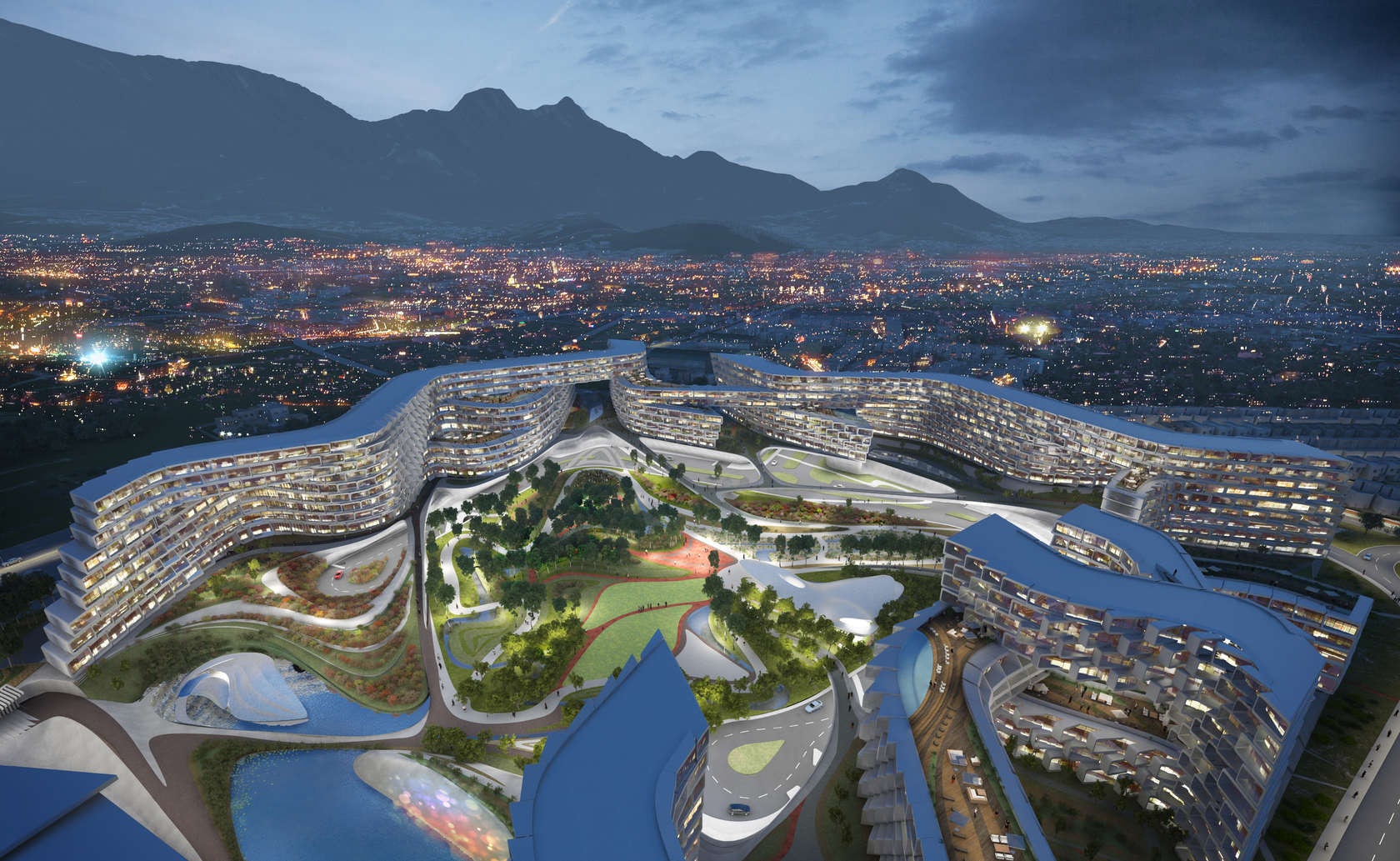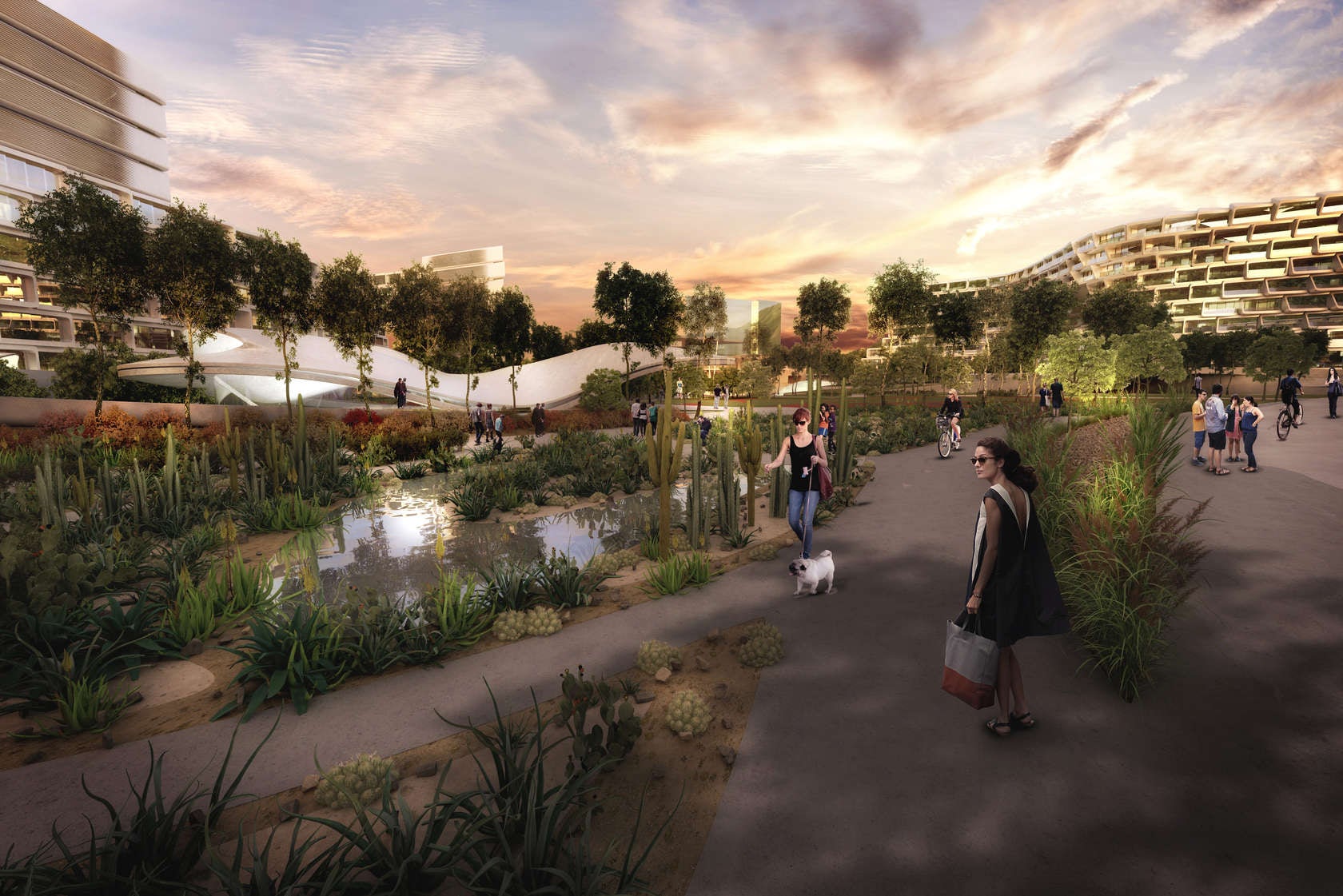Not many parts of the world have yet to be touched by the influential hand of Dame Zaha Hadid, but Central America had been one of them … until now. Following her first foray into South America — the proposal for a spine-like condominium in Rio de Janeiro was revealed late last year — the British-Iraqi architect has now ventured further north, unveiling a large, high-density residential master plan for a site in the Mexican city of Monterrey.

Esfera City Center will form a major new addition to the southeast of the country’s third largest city, situated within Huajuco Canyon, a long valley framed by two mountain ranges. The expansive scope of the scheme includes 981 apartments, a gymnasium, multiple swimming pools, a chapel, and a wide variety of public and private outdoor amenity spaces. It constitutes one of the largest housing developments designed by ZHA to date and will be constructed in three phases, with the first slated for completion come 2018.
A slick fly-through video accompanies the newly released renderings, possessing the same achingly cool cinematic style that the firm’s CGI artists have become renowned for over recent years (see the full range of trailers here). The context pulses into life to the beat of Matthew Herbert’s “The Audience”: waves of light emerge from the ground before solidifying to form buildings and the sinuous veins of a 320,000-square-foot public park are traced across the interior of the site. These classic curvilinear features are unmistakably Hadid, drawn like a fluid signature across the landscape.

The design brief for Esfera is notable for its evolution during the course of the project, with Hadid showing an unparalleled ability to influence major clients on large-scale aspects of their development. Mexican developer Citelis originally called for a series of homogenous residential towers surrounded by landscape, conjuring visions of Le Corbusier’s “Plan Voisin,” together with its well-documented urban planning pitfalls. However, ZHA had other ideas: they proposed a low-rise ribbon of interlaced apartment blocks, creating a continuous boundary around the perimeter of the site with an expanse of protected parkland at its heart.

The move away from the high-rise residential typology reflects opinions of many urban theorists who have argued that such architecture brings with it social fragmentation and a lack of “community” in urban areas. Instead, Hadid’s undulating wall of apartments rises to a maximum of nine stories, and varied amounts of permeability through the blocks offer connectivity — both in terms of pedestrian movement and via key visual corridors — between the interior and exterior of the development.
The upper levels of these snaking blocks split and curl away from those below them at regular intervals, revealing space for vast external terraces with sweeping views over both the internal plaza and the rest of Monterrey. These elevated decks — incorporating some exceedingly sophisticated garden furniture and every native cacti species imaginable — are reminiscent of the external spaces found throughout The Interlace, OMA’s striking stack of residential Jenga blocks in Singapore.

As with the Rem Koolhaas project, these decked areas form a bridge between the intimacy of conventional gardens and the communal atmosphere of public parks and recreation spaces, offering residents a variety of external amenities on their doorstep. Furthermore, the saw-toothed outer skin of the complex — created by triangular balconies protruding from every apartment — bears a sculptural similarity to Julien de Smedt’s spiky Gangnam Bogeumjari District Officetel combined with the zigzagging shading partitions of the Ragnitzstrasse residential block by LOVE Architecture.

Zooming back out, the horizontal emphasis of the development represents a significant shift in approach from ZHA when it comes to their residential work. Previously, verticality had been the order of the day: a fluted trio of towers was proposed for the firm’s debut in Australia, whilst the One Thousand Museum condominium in Miami is a dramatic elongation of Zaha’s typically low-rise parametric language.
The success of the project remains to be seen, and there are certainly reasons to be cautious. The layout of the complex as a whole, with a continuous curtain of built structure wrapping around a large landscaped public space, bears an uncanny resemblance to Robin Hood Gardens in London, a postwar housing scheme that became infamous for its troubled social history and a high-profile preservation campaign — supported, notably, by Zaha Hadid.

According to detractors, the issues pertaining to crime, poverty, and vandalism within that development show how high-density housing can inadvertently become an incubator for social deprivation. However, the crucial difference between Robin Hood Gardens and Esfera is a simple one: it all comes down to money.
While the residents of the London development had little and their estate received insufficient upkeep by local authorities, Esfera will undoubtedly be populated by a wealthier demographic, and their lifestyle will be catered to accordingly: maintenance of common areas and property security will be paramount. Rightly or wrongly, it looks likely that there will be a thread of exclusivity running through this new quarter of Monterrey — and when it comes to luxury for the upwardly mobile, ZHA knows exactly what is required.




